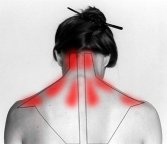… The Top Solutions, Causes, and Symptoms
Unlike your lower back, which provides a great deal of mobility for movement, your upper back is relatively stable, providing support for standing upright and protecting your heart, lungs and other vital organs in your chest. Because movement is limited, injury and degeneration is far less common than it is in the lower back — but that doesn’t mean it doesn’t occur.
 Upper back pain, which can extend from the base of your neck to the bottom of your rib cage, can be sharp and shooting, or dull and burning. It may also occur along with muscle stiffness or, in severe cases that require immediate medical attention, weakness, numbness or tingling in your arms or legs, or loss of bowel or bladder control.
Upper back pain, which can extend from the base of your neck to the bottom of your rib cage, can be sharp and shooting, or dull and burning. It may also occur along with muscle stiffness or, in severe cases that require immediate medical attention, weakness, numbness or tingling in your arms or legs, or loss of bowel or bladder control.
You may not realize how important your upper back is to your daily functions … until upper back pain occurs. If you suffer an injury to your upper back, simple activities like brushing your teeth or driving a car can become unbearably painful. Although, more often, the pain creeps up insidiously over time, the cumulative result of years spent hunched over in front of your computer or steering wheel, or bent over digging in your yard …
The Common, Insidious Causes of Upper Back Pain
The two most common reasons for upper back pain are trauma and muscle imbalances, the latter being responsible for what are called “postural dysfunctions.” These postural dysfunctions cause abnormal alignment of your head and shoulders and abnormal positioning of the joints that lead to increased wear and tear on the joints, muscles, and ligaments — even discs.
Many common activities and conditions can contribute to muscle imbalances that cause upper back pain over time, including:
- Carrying a heavy backpack
- For women, having large breasts
- Poor posture while sitting or standing
- Repetitive motions, such as using a shovel
- Pregnancy
If You Want Lasting Relief, You’ve Got to Treat the Cause
Every day your back takes a beating, so it’s important to give it the proper care it needs to function optimally. At the most basic level, this means taking time to stretch and rebalance your muscles regularly throughout the day, and avoiding activities that put strain on your upper back muscles.
If your backpack feels too heavy, make it lighter. If you sit at a desk all day, make sure you are using a proper ergonomic back-supportive office chair and use this mid-back stretch to keep your thoracic region open and well-balanced.
If you’re a woman with larger breasts, consider wearing a sports bra that supports the weight of your breasts evenly, or invest in a custom option that distributes your breast weight better across your body.
Oftentimes, the muscles in your upper back may also be affected by myofascial pain, which is characterized by aching “knots” also known as “trigger points.” If left untreated they can become a center for irritation and inflammation in your muscles and nerves. This ongoing inflammation leads to fibrosis, which thickens your connective tissues. Thicker connective tissue is less flexible, leading to a vicious cycle of additional irritation, tension, and pain as your body pulls on each trigger point.
When in the “active” phase, trigger points are very painful, although the pain may be “referred pain,” meaning it can be felt in seemingly unrelated parts of your body. Because of this, trigger points are often completely missed as your source of pain, as you could be feeling pain in your buttocks, hip or even down your leg but the actual trigger point needing to be released is located in your upper back.
Trigger point therapy involves applying deep, manual pressure to trigger points to relieve pain. You can go to a massage therapist, physical therapist, chiropractor or even a trigger point specialist to receive manual trigger point therapy, but the success of the treatment depends on the skill level of the practitioner. As an alternative, you can also perform trigger point therapy on yourself, in the comfort of your own home.
Think Pain Medications are Your Only Option? Not if You Want Lasting Relief
Pain medications are the go-to treatment for back pain for many physicians, but this doesn’t make them the best. In fact, painkillers and anti-inflammatories are among the most dangerous medicines on the market, linked to everything from perforated ulcers and gastrointestinal bleeding (aspirin and other NSAIDs) to liver failure (Tylenol) to even tripling your risk of heart attack (Celebrex).
As for surgery, this is still a rare occurrence for upper back pain (surgery for back pain is only performed in about 5% of all cases, and only 1% of all disc herniations occur in the upper back, due to its stability). This is fortunate because, as with pain medications, surgery does nothing to address the reasons why your back pain likely developed. This means that even if you’re able to temporarily relieve your pain using a drug, it will return as soon as you stop taking it. It may even be worse because you’ve continued the patterns of movement that put abnormal stress on your muscles, ligaments and joints.
 Again, muscle imbalances (and painful trigger points) are the cumulative effect of everyday occurrences such as:
Again, muscle imbalances (and painful trigger points) are the cumulative effect of everyday occurrences such as:
- Typing on your computer
- Carrying a heavy purse or briefcase
- Lifting your baby or toddler
- Poor posture
- Sitting for long periods in poorly designed furniture
- Tensing or clenching your muscles due to anxiety or emotional stress
If you’re one of the many who are currently struggling with upper back pain, you owe it to yourself to explore the Lose the Back Pain System, which takes you step-by-step through the process of identifying the exact muscle imbalances you have. It then gives you the targeted stretches and exercises you need to get fast upper back pain relief. Thousands of physicians prescribe this system, and tens of thousands of people like you have already experienced its lasting results.
To stay on top of the latest advances in upper back pain relief, and to receive more tips to becoming pain free, subscribe to LosetheBackPain.com’s free newsletter using the subscribe button in the upper right corner of this page. You, too, can join the growing numbers of people who have beat back pain naturally and are now living their lives pain free.


